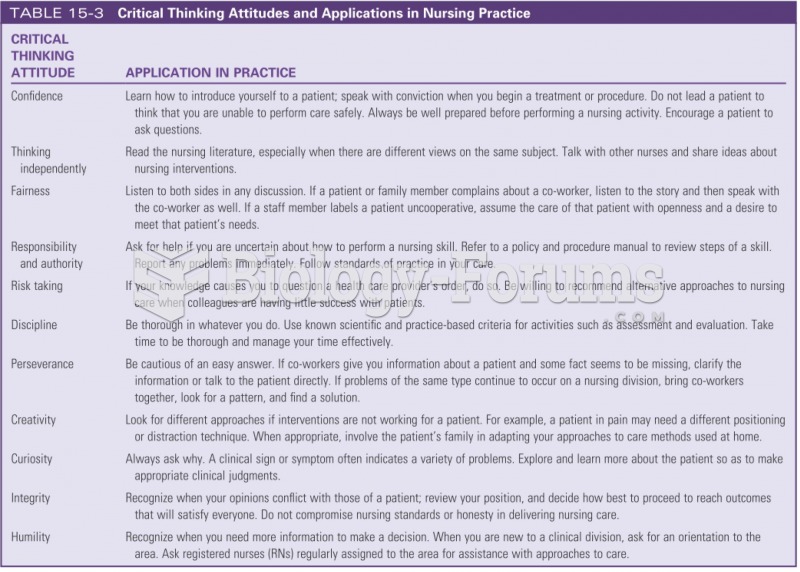Answer to Question 1The issues in this case are complex. The teacher, as well as the employer, made decisions that were both good and bad. The collaboration at the end of the case, and the suggested use of the social worker, were exemplar. However, the fact that the situation wasn't dealt with immediately is a point of contemplation.
Duncan's anger obviously influenced his behavior in this case. He acted out by writing an email to Patricia Cywinski. He appears to be unable to see his own influence on this situation.
The information is consistent with professional literature. It is common for students with disabilities to be placed in vocational settings as a part of their transition plan on their IEP. In many cases, social skills become an issue in these employment settings. This is also true for some, but not all, students with learning disabilities.
No, this case is complex and presents multiple perspectives. Neither the teacher nor the employer appear to assume that social skill training will automatically make Duncan's social behavior appropriate.
It is possible that both Griffin Nagel and Patricia Cywinski stereotyped Duncan by assuming he would have fewer problems in the work situation than a student with more significant needs. Often, people believe that learning disabilities are mild, and therefore, the student needs less support. If Duncan were given more support early on, this situation might have been avoided. On the other hand, if one were to believe that all students with learning disabilities were socially deficient, that would be a stereotype. There are many students with learning disabilities that are very socially adept.
Griffin Nagel demonstrates positive dispositions by listening as Patricia Cywinski describes the situation. He acknowledged her feelings by saying, I can hear the frustration in your voice, at one point in their conversation. He was also very straight forward with Patricia, pointing out what she had done well but telling her that she should have consulted him earlier when she recognized there might be a problem. Additionally, Griffin seems very reflective and suggests collaborating with the social worker to help Duncan. However, Griffin may have been wrong in assuming that Duncan would automatically do well based on his intellectual ability. Griffin may have made this assumption based on the disability category and not on personal interactions with the student. It is never good to base beliefs about a person on a label.
Patricia Cywinski probably could have prevented the situation from becoming this extreme by speaking with Griffin Nagel every time an inappropriate incidence occurred. Then, the two of them could have discussed each incidence with Duncan directly. Just as students need immediate correction for a math or reading error, they need immediate corrective feedback for social errors also. If Patricia and Griffin had taken the opportunity to discuss each social error, and then taught Duncan appropriate social skills, these problems may have decreased or been eliminated. Instead the problems only escalated.
He seems mostly upset that Patricia didn't talk to him at the time he did something wrong. He feels she went to his teacher behind his back in an attempt to get him in trouble in school.
Teachers have the right to share information with other teachers and those who work directly with students. The information shared needs to be directly related to the class, issue, or situation. In this case, it's a judgment call on whether Griffin Nagel overstepped the bounds of confidentiality when he shared information about Duncan's home life with Patricia Cywinski. All teachers need to be respectful and use good judgment when speaking about students with special needs. Parents and students with disabilities are assured the right of confidentiality under IDEA.
Dyscalculia is a term referring to a wide range of life-long learning disabilities involving math. There is no single form of math disability and difficulties vary from person to person. Dyscalculia may manifest itself in the inability to:
- understand concepts of place value, quantity, number lines, positive and negative value, carrying and borrowing
- understand and do word problems
- sequence information or events
- use steps involved in math operations
- understand fractions
- make change and handle money
- recognize patterns when adding, subtracting, multiplying, or dividing
- understand concepts related to time such as days, weeks, months, seasons, quarters, etc.
- organize problems on the page, keep numbers lined up, and follow through on long division problems
Many, however certainly not all, students with learning disabilities have difficulty with social skills. This is often referred to as a social learning disability. Just as students with learning disabilities have difficulty perceiving or understanding printed text or sounds, they may have difficulty reading social situations. They are often unable to read facial gestures, body language, or vocal utterances that communicate the feelings of others. For example, the student with a social learning disability may tell a joke, and after the joke, others might laugh weakly. The student with the learning disability may assume the laughter means the joke was well received, when in fact, the others laughed because they were embarrassed, offended, or were making fun of the student with the learning disability. Teaching students appropriate social skills, such as how to gain attention properly, make friends, joke, wait in line, take turns, etc., can greatly benefit the student with a social learning disability.
Answer to Question 2This case is a contemplation case, because it presents opposing sides of an issue. Both of the issues have information and opinions that could be considered correct and incorrect.
Emotions play very heavily into both of these arguments. Both teachers appear to feel threatened by the other. They are angry and are having a difficult time understanding the other's point of view, because their emotions are clouding the issues.
Yes. The information is consistent with professional literature. Many students, with cognitive delays, need appropriate social skills and sexuality education. This is important to help them maintain appropriate relationships. Mrs. Phelps is correct, in that students with disabilities are more likely to be sexually abused than students without disabilities, and they need to be taught appropriate social skills and communication skills so they are better prepared to protect themselves against abuse.
No, this issue presents both perspectives of the case. There is no easy answer suggested.
Allen Sears may be stereotyping Sydney. He is assuming, that because Sydney's cognitive functioning ability is that of a small child, she should be treated as a little girl. She is, in fact, a young woman, and should be treated as such.
Both teachers are exhibiting some dispositions that may cause a barrier to problem solving. They appear to be intolerant of each other's point of view and unable to see the other person's perspective. Although both want what is best for Sydney, they seem to be name calling and labeling each other. Neither is being an effective advocate for Sydney at this time.
Allen wants to maintain his friendship with Sydney Galinski. He wants to make her feel special and accepted at the Middle School. He wants to maintain the status quo. He doesn't want to hurt Sydney's feelings or embarrass her by talking about her behavior
Melinda Phelps wants to teach Sydney about appropriate and inappropriate behavior and interactions with the opposite sex. She wants Allen to stop giving Sydney hugs in the hall and meeting her before class every day. She doesn't want to baby Sydney because of her cognitive delay or her health issues.
Allen sees Sydney as a little girl. He views her more like a five-year old than a twelve-year old. He doesn't understand the sexual development of students with cognitive delays. He is unaware that even though her mental ability is like a kindergartener, her physical maturity is like a teenage girl. Because he has known Sydney all of her life, it's more difficult for him to see her as a young woman. Melinda's relationship with Sydney is new and, therefore, she sees her development as in line with a twelve-year old. She has had experience with students with cognitive delays and can see her developing sexual urges. She believes Sydney understands her actions and feels Sydney should be accountable for those actions. Melinda doesn't believe Sydney doesn't know what she is doing.
Some students with disabilities don't naturally learn appropriate social behavior. They must be taught. Direct social skills lessons, to foster critical thinking and independent actions, are a necessity. I would use a social skills curriculum that was approved by my administrator and Sydney's parents. I might also use activities including: role-playing, social stories, bibliotherapy, and use of a structured social skills curriculum. Because students with disabilities have difficulty transferring or applying learning, they must practice new social skills in supported environments. Adults must also model appropriate interactions.
It is important for teachers to remember that students are not our friends, no matter how much we like them. At the same time, teachers need to be warm and nurturing. Students should feel comfortable talking with teachers, but we want to make sure that we don't engage in inappropriate conversations. Teachers should refrain from having social conversations that discuss sexuality or sensitive topics. It is, however, appropriate to teach issues of sexuality using the district's approved curriculum. But there is a time and place for that. Teachers should try to make physical contact with students in appropriate ways, like a high five instead of a hug. This is especially important when the student is older.







